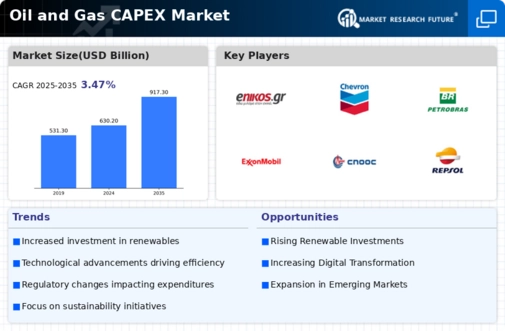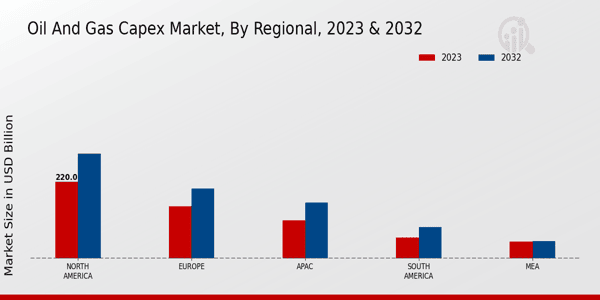Geopolitical Factors
Geopolitical dynamics are a critical driver of the Global Oil and Gas CAPEX Market Industry. Political instability in oil-rich regions can lead to supply disruptions, prompting companies to invest heavily in securing alternative sources and enhancing infrastructure. For example, tensions in the Middle East often result in fluctuating oil prices, which can influence capital expenditure decisions. In response, firms may increase their investments in exploration and production in more stable regions to mitigate risks. This strategic shift underscores the importance of geopolitical considerations in shaping the capital allocation strategies of oil and gas companies, as they navigate an increasingly complex global landscape.
Regulatory Environment
The regulatory landscape significantly influences the Global Oil and Gas CAPEX Market Industry. Governments worldwide are implementing stricter environmental regulations aimed at reducing carbon emissions and promoting sustainable practices. These regulations compel companies to invest in cleaner technologies and processes, thereby increasing capital expenditures. For instance, initiatives to transition towards renewable energy sources may require oil and gas firms to allocate substantial resources for compliance and innovation. While these regulations may pose challenges, they also present opportunities for investment in cleaner technologies, potentially reshaping the industry's capital allocation strategies in the coming years.
Market Growth Projections
The Global Oil and Gas CAPEX Market Industry is poised for growth, with projections indicating a market size of 630.2 USD Billion in 2024 and an anticipated increase to 917.3 USD Billion by 2035. This growth trajectory, characterized by a CAGR of 3.47% from 2025 to 2035, reflects the industry's resilience and adaptability in the face of evolving energy demands. Investment in exploration, production, and technological advancements will be crucial to sustaining this growth. Stakeholders must remain vigilant in monitoring market trends and adjusting their strategies accordingly to capitalize on emerging opportunities and mitigate potential risks.
Technological Advancements
Technological innovations play a pivotal role in shaping the Global Oil and Gas CAPEX Market Industry. The adoption of advanced drilling techniques, such as horizontal drilling and hydraulic fracturing, has enhanced extraction efficiency and reduced operational costs. These advancements enable companies to tap into previously inaccessible reserves, thereby increasing production capacity. As a result, capital expenditures are likely to rise as firms invest in new technologies to maintain competitiveness. The ongoing integration of digital technologies, including data analytics and automation, further supports this trend, allowing for more precise decision-making and operational optimization, which is crucial for the industry's future growth.
Rising Global Energy Demand
The Global Oil and Gas CAPEX Market Industry is driven by the increasing demand for energy across various sectors. As economies grow, particularly in developing regions, the need for reliable energy sources intensifies. In 2024, the market is projected to reach 630.2 USD Billion, reflecting a robust investment in exploration and production activities. This demand is expected to continue rising, leading to an estimated market size of 917.3 USD Billion by 2035. The compound annual growth rate (CAGR) of 3.47% from 2025 to 2035 indicates a sustained commitment to capital expenditures in oil and gas, as companies seek to meet the energy needs of a growing global population.
Market Volatility and Price Fluctuations
Market volatility and price fluctuations are inherent challenges within the Global Oil and Gas CAPEX Market Industry. The cyclical nature of oil prices can lead to unpredictable capital expenditure patterns, as companies adjust their investment strategies based on current market conditions. During periods of high prices, firms may ramp up spending on exploration and development, while lower prices can result in budget cuts and deferred projects. This volatility necessitates a careful balancing act for companies, as they strive to optimize their capital allocation while responding to the ever-changing market dynamics. Understanding these fluctuations is essential for stakeholders to navigate the complexities of the industry.













